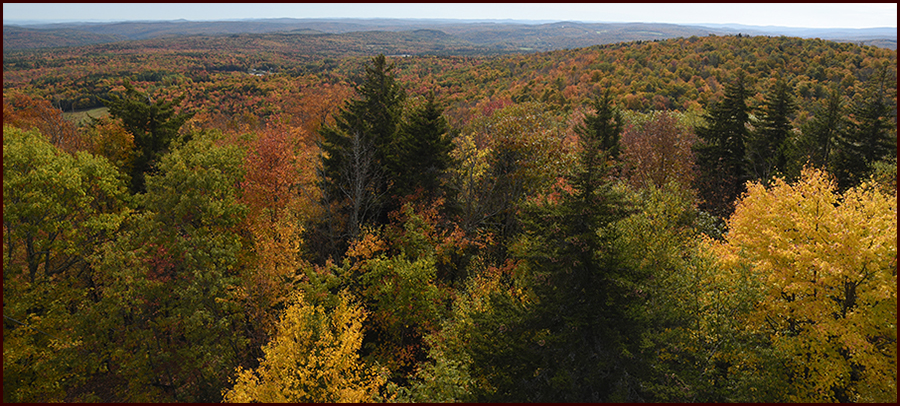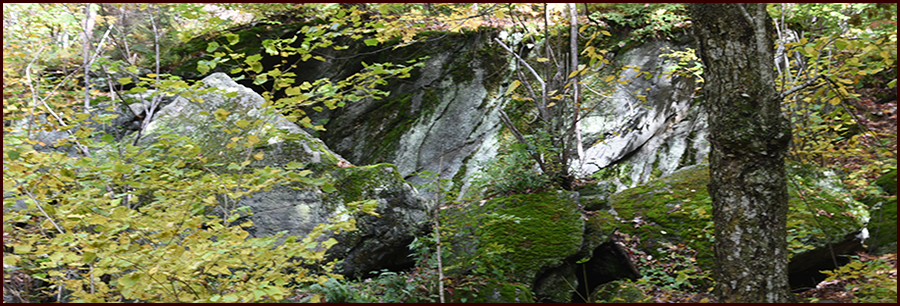Margery Grey Words & Music by Steve Gillette
They say that in colonial times the forests in New England were so thick that a squirrel could start out in Boston and travel all the way to the Hudson River without touching the ground. It was true that there was a great danger of getting lost in the woods if one wandered too far from the path.
This is a story song, based on several historic tales. It’s been a part of regional folklore since the seventeen hundreds. The contention that someone could walk all the way to the headwaters of the Connecticut River to cross from Vermont into New Hampshire does stretch credulity, but it is true that many were lost in the dense forest and never found their way home.
At this moment we are experiencing the first frost here in Southern Vermont. For the last couple of weeks we’ve seen signs of the onset of the Fall. The Autumn Joy Sedum has blushed with a strong lavender from it’s earlier pink, the echinacea and the bee balm have lost their petals. In the song we mention the goldenrod and the aster, two of the indicators of the approaching winter, and of course, the turning of the leaves.
This event will draw thousands of visitors to the region. Vermont is known for what is usually the most intense fall display. This has to do with the color changes being condensed into just a few weeks due to the mixed hardwood forests and the cold nights and warm days.
Along with the this display, there is the ages-old awareness of the approach of winter, and the dangers of the cold and dark. Even if the old fears of freezing or starving to death are gone, there is a tendency toward emotional depression which is always a part of the darker and shorter days.
For those who have lived in the region for many years, there is an acceptance of this more somber time, and even a sense of celebration at the turning of the great wheel, or at least our little wedge of it as we cycle through the autumnal equinox.
That too is a part of the story of this song. Also the clinging to life and the connection to family and the pain of not being able to defend those we love from the inevitable, the ineluctable dance with mortality.
One of the things that has drawn us to folk music and the tradition of narratives of community and true human experience and concerns, is the humble honesty and surprising insight of common wisdom. Folk songs have worn off their corners like stones tumbling in a stream, and have not been subjected to the sanitizing of the commercial marketplace. There is wisdom in the old tales that doesn’t always comport with the sponsor’s ambitions.
Why would we seek out and write songs that take on the dark side, the forest primeval, the nightmare scenario? What reason is there to delve into the dark if not to seek a greater wisdom? Danger, terror, desperation are as much a part of the storyteller's and the songwriter's paintbox as love and joy.
In an article entitled "The Lure of Horror" from The British Psychological Society, I found the quote, “Fear coils in your stomach and clutches at your heart. It’s an unpleasant emotion we usually do our best to avoid. Yet across the world and through time people have been drawn irresistibly to stories designed to scare them. Writers like Edgar Allen Poe, H.P. Lovecraft, Stephen King, and Clive Barker continue to haunt the popular consciousness. Far longer ago, listeners sat mesmerized by violent, terrifying tales like Beowulf and Homer’s Odyssey.”
Cindy has explored this territory for years. She loves the grisly old Scottish ballads with Shakespearean mayhem and blood. Watch her videos of the ballads, "The Cruel Mother" and "The Two Sisters." These songs are stark and chilling and can have a dramatic effect in a concert. But I’ve always cautioned that we should have only ‘one open grave per set.’
We first heard the story of Margery Grey in the singing of our friend Margaret MacArthur. She sang what was a true ballad, at least thirteen verses as I remember it. She based her version on the poem by Julia C. Dorr which has twenty-three stanzas. Patrick Sky researched the song for a thesis he wrote at Goddard College.
In Margaret’s notes she says: “Julia Dorr’s late nineteenth-century poem Margery Grey, in starkly portraying the trials of a pioneer woman, clearly and poignantly illustrates the perils of frontier life. It has been loved by countless Vermonters, as evidenced by the number of versions in the Flanders Collection.” (This archive now at Middlebury College represents the life work of Helen Harkness Flanders who lived from 1890 to 1972.)
Members of the extended Grey family would come to hear Margaret and request the song. They all knew the words so if she hesitated at any point, they would prompt her with a faultless recall of every line.
We were drawn to the story and wanted to sing the song, but it was quite long and convoluted, with so many details that I resorted to the folk process to condense the story into a more manageable form. It’s still a little on the long side, but I sought to relieve that by giving some variation to the melody of the two-part verse form.
The melody and the harmony use many of the features of changing modes. The song seems to be in E minor, but makes its way through turns that call upon harmonic colors from the major chords of D, G, and C. The second half takes a much more positive turn starting off with the G major and then working its way back to the darker harmonies.
The challenge was to make the sections different enough from each other to keep the long narration fresh. One device that is used several times in the melody is to reach up for what is sometimes called a ‘leading tone,’ a note that seems to call for a resolution. This can heighten the drama if it supports the ideas or images of the lyric at that point.
Going to the G chord before the D gives the opportunity to ‘reach’ for the G note and pull it back to the F# of the D chord. This could also be likened to the 4-3 suspension when the fourth degree of the key is sung against the tonic chord and then resolved downward by a half step as in the ‘amen’ ending. Suspensions can also use the 7-8 interval, and even the 2-1. More on suspensions in The Songwriter’s Almanac.
Cindy and I recorded the song on our CD A Sense of Place. The video uses that track, with Cindy on concertina and me on guitar parts.
"Margery Grey" - Audio from A Sense of Place.
Video by Steve
The CD A Sense of Place, is available here.
The sheet music is contained in my songbook along with 46 other songs (available here). But I’ve included the chords here for you to experiment with, and I recommend playing along with the video to get the full effect.
Here are the lyrics and chords:
The
She heard a
But for
Another
Rushing
She found the
She saw
So
‘Til like
The
Until the
She
And
With
Til the
And the
And the
Into the
Looking
In
A
But had
© 2000, Compass Rose Music, BMI


